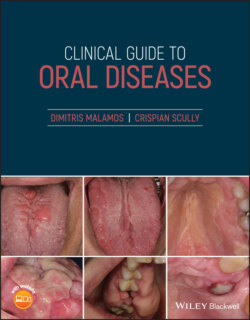Читать книгу Clinical Guide to Oral Diseases - Crispian Scully - Страница 56
Case 4.9
ОглавлениеFigure 4.9
CO: A 62‐year‐old woman was presented for evaluation of her bad breath.
HPC: Her bad breath was first noticed by her husband four days ago, and was more intense in the mornings and slightly improved during eating or brushing her teeth. Her halitosis appeared at the same time with a febrile viral infection of her mouth and throat.
GMH: Diabetes and mild hypertension were her main medical problems and were under control with drugs and daily exercise. Smoking was stopped after an episode of pneumonia last year.
OE: A whitish yellow asymptomatic thick coating was found, on the dorsum of her tongue, which was partially removed with scraping (Figure 4.9) and associated with sore throat, stuffy nose, mild fever (<38 C) and cervical lymphadenitis. Her oral hygiene was inadequate and the patient wore partial ill‐fitted dentures. Malodor was noted during examination.
Q1 Which is the main origin of her bad breath?
1 Furry or coated tongue
2 Stuffy nose
3 Mouth breathing
4 Fever‐induced dehydration
5 Bad prostheses
Answers:
1 Bad breath was caused mainly by degradation of food debris and necrotic epithelial cells from various anaerobic bacteria that located on the dorsum of the tongue (white coat), found in large quantities in upper respiratory viral infections.
2 No
3 No
4 No
5 No
Comments: The oral dehydration facilitates the growth of a number of bacteria, including those responsible for bad breath. However, in this patient, the dehydration was not severe, as the mouth breathing and fever were neither intense nor high. Her poor OH and bad prosthesis caused constant malador, which was not restricted to the period of her febrile illness.
Q2 Which other diseases have similar clinical features with this condition?
1 Acute pseudomembranous candidiasis
2 Black hairy tongue
3 Hairy leukoplakia
4 Lichen planus
5 Geographic tongue
Answers:
1 Acute pseudomembranous candidiasis, or thrush, also develops white lesions on the dorsum of the tongue which are easily scraped off, but cause a tingling or burning sensation and leaving erythematous areas underneath.
2 No
3 No
4 No
5 No
Comments: Other white lesions on the dorsum of the tongue are persistent as in lichen planus and hairy leukoplakia, or transient as in geographic tongue. However all the above lesions are not associated with halitosis and have different symptomatology and clinical features. The black hairy tongue lesion differs in the color and the length of the filiform papillae, as the patient's tongue coat is whitish and not black, while the length of the filiform papillae is normal.
Q3 Which other conditions are associated with similar furry tongue lesions?
1 Scarlet fever
2 Cold
3 Sjogren syndrome
4 Chronic pneumonia
5 Hyperplastic candidiasis
Answers:
1 Scarlet fever is an acute infection from Streptococcus A bacterium and characterized by white coating on the tongue, gradually changing into a strawberry‐like appearance due to the inflammation of taste papillae and associated with sore throat, fever, swollen glands as well as a generalized sandpaper skin rash.
2 Cold is an acute viral infection of the upper respiratory system that is characterized by sore throat, runny nose, white furry tongue and accompanied with cough, fever, muscle aches and general fatigue as well.
3 No
4 No
5 No
Comments: Sjogren syndrome, chronic pneumonia, and hyperplastic candidiasis are often associated with furry tongue but with different etiology clinical picture or and duration.
